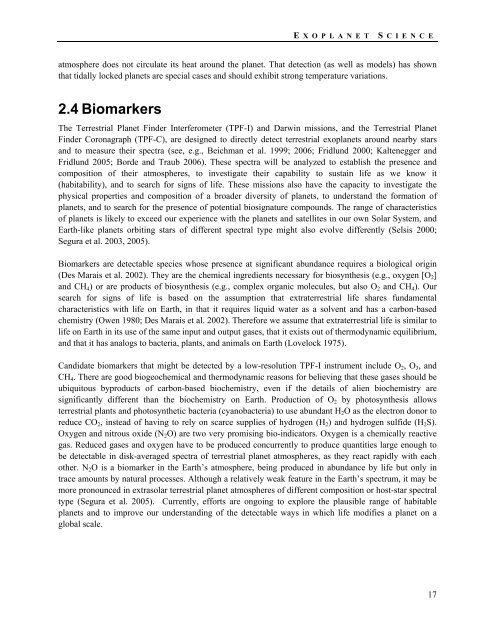TPF-I SWG Report - Exoplanet Exploration Program - NASA
TPF-I SWG Report - Exoplanet Exploration Program - NASA
TPF-I SWG Report - Exoplanet Exploration Program - NASA
You also want an ePaper? Increase the reach of your titles
YUMPU automatically turns print PDFs into web optimized ePapers that Google loves.
E X O P L A N E T S CIENCE<br />
atmosphere does not circulate its heat around the planet. That detection (as well as models) has shown<br />
that tidally locked planets are special cases and should exhibit strong temperature variations.<br />
2.4 Biomarkers<br />
The Terrestrial Planet Finder Interferometer (<strong>TPF</strong>-I) and Darwin missions, and the Terrestrial Planet<br />
Finder Coronagraph (<strong>TPF</strong>-C), are designed to directly detect terrestrial exoplanets around nearby stars<br />
and to measure their spectra (see, e.g., Beichman et al. 1999; 2006; Fridlund 2000; Kaltenegger and<br />
Fridlund 2005; Borde and Traub 2006). These spectra will be analyzed to establish the presence and<br />
composition of their atmospheres, to investigate their capability to sustain life as we know it<br />
(habitability), and to search for signs of life. These missions also have the capacity to investigate the<br />
physical properties and composition of a broader diversity of planets, to understand the formation of<br />
planets, and to search for the presence of potential biosignature compounds. The range of characteristics<br />
of planets is likely to exceed our experience with the planets and satellites in our own Solar System, and<br />
Earth-like planets orbiting stars of different spectral type might also evolve differently (Selsis 2000;<br />
Segura et al. 2003, 2005).<br />
Biomarkers are detectable species whose presence at significant abundance requires a biological origin<br />
(Des Marais et al. 2002). They are the chemical ingredients necessary for biosynthesis (e.g., oxygen [O 2 ]<br />
and CH 4 ) or are products of biosynthesis (e.g., complex organic molecules, but also O 2 and CH 4 ). Our<br />
search for signs of life is based on the assumption that extraterrestrial life shares fundamental<br />
characteristics with life on Earth, in that it requires liquid water as a solvent and has a carbon-based<br />
chemistry (Owen 1980; Des Marais et al. 2002). Therefore we assume that extraterrestrial life is similar to<br />
life on Earth in its use of the same input and output gases, that it exists out of thermodynamic equilibrium,<br />
and that it has analogs to bacteria, plants, and animals on Earth (Lovelock 1975).<br />
Candidate biomarkers that might be detected by a low-resolution <strong>TPF</strong>-I instrument include O 2 , O 3 , and<br />
CH 4 . There are good biogeochemical and thermodynamic reasons for believing that these gases should be<br />
ubiquitous byproducts of carbon-based biochemistry, even if the details of alien biochemistry are<br />
significantly different than the biochemistry on Earth. Production of O 2 by photosynthesis allows<br />
terrestrial plants and photosynthetic bacteria (cyanobacteria) to use abundant H 2 O as the electron donor to<br />
reduce CO 2 , instead of having to rely on scarce supplies of hydrogen (H 2 ) and hydrogen sulfide (H 2 S).<br />
Oxygen and nitrous oxide (N 2 O) are two very promising bio-indicators. Oxygen is a chemically reactive<br />
gas. Reduced gases and oxygen have to be produced concurrently to produce quantities large enough to<br />
be detectable in disk-averaged spectra of terrestrial planet atmospheres, as they react rapidly with each<br />
other. N 2 O is a biomarker in the Earth’s atmosphere, being produced in abundance by life but only in<br />
trace amounts by natural processes. Although a relatively weak feature in the Earth’s spectrum, it may be<br />
more pronounced in extrasolar terrestrial planet atmospheres of different composition or host-star spectral<br />
type (Segura et al. 2005). Currently, efforts are ongoing to explore the plausible range of habitable<br />
planets and to improve our understanding of the detectable ways in which life modifies a planet on a<br />
global scale.<br />
17
















